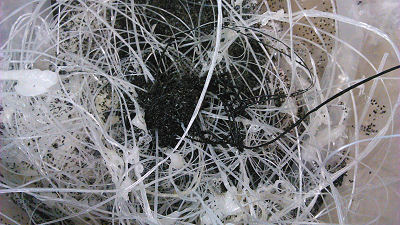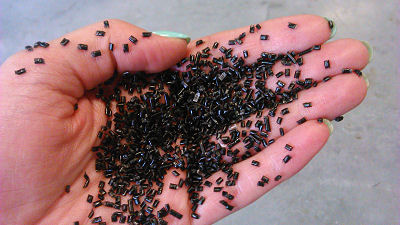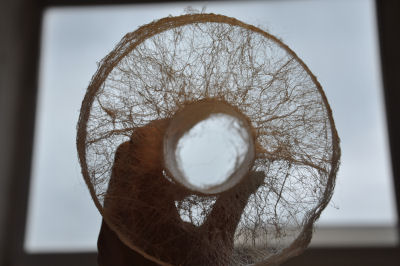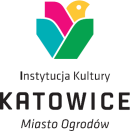| |
 |
"Filtering the invisible"
"Production of non-woven filter materials with nano-composite granulates'
Within the framework of project 'Staż Sukcesem Naukowca'"
Anna Jackiewicz1, Paweł Kmuk2
1PWarsaw University of Technology, Faculty of Chemical and Process Engineering,
Chair of Integrated Process Engineering,
ul. Waryńskiego 1, 00-645 Warszawa
e-mail: a.jackiewicz@ichip.pw.edu.pl
2Secura Nova Sp. z. o.o.,
3 Maja 2/4, 00-391 Warszawa

Black and white polymer threads, Warsaw, 2014

Granulate with nanotubes, Warsaw, 2014

 In the tangle of polymer fibrous, 2014, Warsaw In the tangle of polymer fibrous, 2014, Warsaw
|

|
Description popularizing the research project
When the liquid flowing through a sieve does not leave any traces of impurities on the mesh, it may mean two things: either the liquid is really pure, or the sieve size is too big. The perverse alternative reminds of a saying: 'There are no healthy people, just patients that haven't been examined thoroughly enough'. Travestying it we can reach a disturbing conclusion: 'There is no clean water, just water that haven't been filtered enough' through a too big sieve. Nature knows filters of various kinds. Blue whales, which consume four tonnes of plankton a day, retain it in the mouth, sieving precisely a-few-centimetre-long krill from Antarctic waters. The krill precisely filtering the same waters feeds on much smaller food - tiny algae of diameter of up to one millimetre. For a blue whale a portion of water containing just the algae is like 'distilled', devoid of any nutrient value.
The most precise filters in the nature are cell membranes, which selectively sieve ions of particular diameter. Such precision is a priority at the current stage of evolution in the world of science and technology. Milli scale and micro scale is no longer sufficient in production of electronic and mechanical devices, in medicine and pharmacy. The most advanced branches of science resort to nanoparticles, nanofibers, and other nanoobjects. The by-product of manufacturing them is nanopollution. If it pollutes air, soil and water, it will be a threat to the environment and human health. That is why, like in the nature there is a kind of equilibrium between the filtering and the filtered, among the products of human activity there is a parallel evolution of nanopollutants and nanofilters. We do not know the impact of nanopollutants in the environment on health, but many of them are known to be hazardous, not for their composition but the size. We have no choice - in the future no nanolitter can sneak through a nanofilter that has been too big.
Abstract
Filtration processes are a very important research area, mainly due to environmental and human health protection and technological reasons. The standards governing allowable concentrations of particles are more and more stringent. Thus, to meet the requirements the method of removing particles from fluid used so far should be improved or new ones should be introduced. Non-woven filter materials are a very good tool for separating particles of various morphology from gas and liquid. The range of their applications is very wide (including ventilation and air conditioning systems, various industries, personal protective equipment, diesel engines). The capabilities offered by the materials should be more widely utilized in Polish industry than so far.
Hence the idea of developing the project and producing innovative fibrous filters containing carbon nanotubes of specific properties, effectively separating various types of pollutions. The proposed material will be the first of its kind on the market. The first stage of the work was to produce a polymer composite structure containing carbon nanotubes in a specially designed for the purpose apparatus (twinscrew extruder with a side feeder and plastics granulator). In the next step, non-woven materials will be prepared with the advanced technology of blowing melted polymer (meltblown) using nanocomposite granulates. The research on the effectiveness of the produced filtration media will be carried out on two modern test stands located in the Department of Integrated Processes Engineering WIChiP PW. It is worth mentioning that one of them is the first of its kind in the world to study the filtration of nanoparticles, which are, due to their size, the most dangerous to human health and the environment.
|
|
Komitet Organizacyjny


Sponsorzy




Patronat medialny





|
 2006
2006
 2008
2008
 2010
2010
 2012
2012
 2014
2014







 In the tangle of polymer fibrous, 2014, Warsaw
In the tangle of polymer fibrous, 2014, Warsaw










